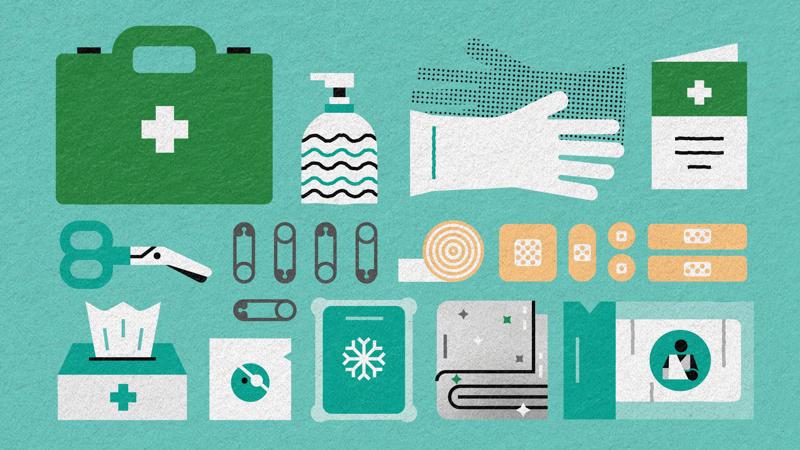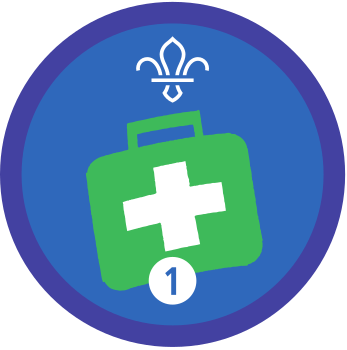
Be an emergency aider: sprains, strains and broken bones
You’ll need
- Chairs
- Bandages
- Triangular bandages (or scarves)
Before you begin
- Make sure the person leading the activity knows about first aid. Someone from your group or local area with a first aid certificate could take charge, or you could reach out to places that help provide first aid training or support, for example, St John Ambulance or the British Red Cross.
- You’ll need enough leaders for the activity, including enough people who are happy to demonstrate first aid techniques.
- Adults should only demonstrate and practise first aid on other adults; young people should only demonstrate and practise first aid on other young people. Adults and young people should never demonstrate or practise first aid on each other.
- Remember that this activity touches on topics that might be sensitive for some people. Give everyone the opportunity to step away if they need to compose themselves.
- Make sure you have enough bandages for everyone to practise – you’ll need enough for one between two. This is a great chance to use up any out-of-date supplies to save breaking into your first aid kit.
- Set up the chairs in a semi-circle facing the speaker and get everyone to sit down.
Learn what to do
- Have a quick chat with everyone to share what they know about sprains, strains, and broken bones. Do they know what could cause them? What are the signs and symptoms? How could a first aider help?
- Explain the signs and symptoms of broken bones, as well as some of the potential causes. They should explain what people can do to reduce the risk.
- Ask if anyone knows anything about slings. People should share what they already know – do they know what they’re used for? How can they help someone who’s broken their arm?
- Ask another adult to help you demonstrate how to put someone’s arm in an arm sling. Making sure you explain what you’re doing every step of the way.
- Everyone should get into pairs of young people. They should take it in turns to practise putting their partner’s arm in an arm sling. Make sure there are some adults walking around so they can help if anyone’s finding it tricky.
- Everyone should repeat steps five and six with an elevation sling.
- Everyone should gather back together and discuss the signs and symptoms of sprains and strains. They should also chat about what causes them and what people can do to reduce the risk of them happening.
- As another adult to help you demonstrate how to treat a sprain or strain with RICE (the acronym – not the food!).
- Everyone should split into groups of three young people. One person should be the casualty, one person should be the first aider, and the third person should watch and help if needed. They should take it in turns to practise treating a sprain or strain with RICE. Everyone should have a turn at being the first aider.
Breaks or cracks in bones are called fractures. In open fractures, the broken bones may pierce the skin surface while in a closed fracture the skin around it’s intact. For detailed and up-to-date information, check out the St John Ambulance website.
Signs and symptoms include:
- deformity, swelling and bruising around the fracture
- pain and/or difficulty moving the area
- a limb may look shorter, twisted or bent
- a grating noise or feeling from the ends of the broken bones
- difficulty or being unable to move the limb normally
- a wound where you can see the bone sticking out (known as an open fracture)
- signs of shock, particularly with a fracture of a thigh bone, hip or pelvis
Treating a broken burn involves covering any wounds, supporting the injured part, padding around the injury, and calling 999. Monitor them and treat them for shock if you need to, but don’t raise an injured leg.
For detailed and up-to-date information, and step-by-step instructions to make slings, check out the pages on arm slings and elevation slings on the St John Ambulance website.
- Arm slings hold the forearm in a raised or horizontal position to support an injured upper arm, forearm, or wrist.
- Elevation slings support the casualty’s forearm and hand in a raised position. They can help to control bleeding and minimise swelling in the forearm or hand.
You can make both types of sling with a triangular bandage – or your necker or scarf. Remember that the casualty would be in a lot of pain, so be gentle!
Sprains and strains are injuries to the soft structure around the bones and joints. For detailed and up-to-date information, check out the St John Ambulance website.
Signs and symptoms include:
- pain and tenderness
- swelling and bruising
- difficulty moving the injured area, especially if it’s a joint
RICE is a useful acronym to remember how to treat a sprain or strain with rest, ice, comfortable support, and elevation:
- Rest the injured part by helping the casualty to sit or lie down and support the injured part in a comfortable position – raise it if you can.
- Ice the area to cool it. You could use an ice pack or frozen vegetables wrapped in a tea towel. The ice can help reduce swelling, pain, and bruising.
- Comfortable support involves leaving the ice pack in place (or wrapping soft padding around the area) and securing it with a conforming bandage. Check it’s not too tight by checking the casualty’s circulation every 10 minutes.
- Elevate the injured part to help minimise swelling and bruising.
Then advise the casualty to rest. If the pain’s severe or they can’t move the injured part, they should seek medical advice.
Reflection
This activity was all about developing skills and being responsible. Did people think of any ways they could reduce the risk of getting injured in different situations? What about while camping, for example? People could think about the measures they’d put in place to keep people safe – and what they’d do if someone did get injured. Can anyone remember the differences between the signs and symptoms of a broken bone compared to a sprain or strain? How would they treat people for each? If they didn’t have a triangular bandage, what else could they use to make a sling?
Safety
All activities must be safely managed. You must complete a thorough risk assessment and take appropriate steps to reduce risk. Use the safety checklist to help you plan and risk assess your activity. Always get approval for the activity, and have suitable supervision and an InTouch process.
If anyone can’t reach their casualty, or is unable to do things like making a sling, they can still learn so they can instruct others. They may want to get into a group of three or four, so they can tell another person what to do to help the casualty.
All Scout activities should be inclusive and accessible.
Put people’s skills to the test by creating some scenarios in your meeting place. Once groups enter, they’ll need to do a primary survey to work out what they need to do. You could also combine the skills people learned in this activity with other emergency aid skills and organise an incident hike.
Young people with first aid qualifications could help others if they’re struggling, with a leader supervising.
